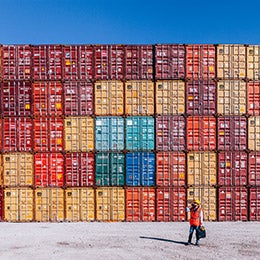
Tariffs and trade wars: What do they mean for investors?
We assess what President Trump’s “Liberation Day” tariffs might mean for US and global markets, European and UK equities, and more.

European equity markets endure volatile month, giving back some of the gains from January and February.
Asia Pacific equity markets were flat for the month, but performance at a country level diverged.
Asia Pacific markets lost ground over the month, but China rallied.
March saw varied performance across global markets. European equities retreated due to fiscal policy shifts and tariff uncertainty, while Germany excelled thanks to a major spending package. The UK faced challenges with weak growth, and US stocks declined as trade tensions affected sentiment. Asia experienced mixed results, with China and India advancing, but Japan and Taiwan slipping due to trade concerns. Emerging markets performed well, led by gains in Latin America and Eastern Europe.
European equities gave up ground during a volatile month in which tariff uncertainty and a seismic shift in European fiscal policy pulled equity markets in opposite directions over March. European equities outperformed US equities, with Germany benefiting from increased fiscal spending. Italy and Spain also performed strongly. Utilities and energy sectors delivered positive returns, while most other sectors, notably consumer discretionary and technology, were in the red. Germany's fiscal policy shift under Chancellor Friedrich Merz included a €1 trillion spending package.
The UK equity market closed lower in March, as investor confidence fell surrounding news of a new wave of tariffs being implemented by the White House. The Bank of England (BoE) kept interest rates unchanged at 4.50% as the BoE reiterated its ‘gradual and careful approach to further interest rate cuts, while warning that economic uncertainty has intensified. Markets continue to expect two cuts overall by the end of the year. The Office for National Statistics (ONS) figures showed that UK inflation slowed in February, falling from 3.0% to 2.8%.
US equity markets declined in March, with the S&P 500 weighed down by concerns about new trade tariffs from the White House. Technology stocks lagged, while energy and utilities fared well. US inflation fell from 3% to 2.8%, supporting the belief that the Fed should resume rate cuts. The Fed kept rates unchanged but projected lower Gross Domestic Product (GDP) and increased inflation. Labour market data showed fewer jobs added, and the unemployment rate rose to 4.1%. Consumer confidence fell to 92.9.
China’s equity market advanced, with retail sales rising. At the National People’s Congress, China pledged stronger fiscal and monetary support, prioritising consumption for 2025. India’s market rose, driven by technology and financial services. Taiwan’s equity market struggled due to slowing export demand and US tariffs. Korean markets slipped back on tariff policy uncertainty. Japanese shares fell ahead of US tariff rollout, with weakened business sentiment. Australian equities dropped due to fears of a global economic slowdown from US trade policies.
Emerging markets gained ground, with Brazil contributing positively. Indonesia's stock market performed well despite concerns over President Prabowo Subianto's policies. Mexican equities rose as tariff postponements allowed Banxico to trim rates. Brazilian equities rose despite fiscal concerns. Eastern European markets advanced on hopes of a ceasefire in Ukraine. Türkiye's equity market and lira plummeted following the detention of Istanbul Mayor Ekrem İmamoğlu.
A volatile month dominated by tariff uncertainty and a significant fiscal shift in Europe. Fears of US tariffs led to rising inflation expectations and a downgraded growth outlook, steepening the US yield curve. Treasuries rallied, returning 0.2% over March. The Federal Reserve kept rates steady at 4.25%-4.50% and slowed quantitative tightening. European government bonds sold off as Germany announced a €500 billion infrastructure fund. The ECB cut rates to 2.5%. UK inflation fell to 2.8%, but the economy stagnated. Corporate bond markets delivered negative returns.

Tariffs and trade wars: What do they mean for investors?
We assess what President Trump’s “Liberation Day” tariffs might mean for US and global markets, European and UK equities, and more.

Global Fixed Income Strategy Monthly Report
In our regularly updated macroeconomic analysis we offer an outlook for interest rates and currencies – and look at which fixed income assets are favoured across a range of market environments.

Geopolitics vs. fundamentals: The tug-of-war in equity markets
Stephen Anness and Joe Dowling discuss why strong company fundamentals drive long-term performance, emphasizing the importance of focusing on business quality over short-term market turbulence caused by geopolitical events.

Reflections from Invesco Real Estate’s Value Add Team
Invesco Real Estate’s value-add team discusses its approach in a challenging market highlighting a disciplined, local team-based execution programme and strategic investments in sectors like logistics and living.

Private credit: quarterly market snapshot
Significant focus on the uncertainty of the US macroeconomic backdrop and its potential headwinds on the market remain top of mind for investment opportunities globally. Against this cautious outlook, we asked the experts from Invesco’s bank loan, direct lending and distressed credit teams to share their views as the first quarter of 2025 begins.
The value of investments and any income will fluctuate (this may partly be the result of exchange rate fluctuations) and investors may not get back the full amount invested.
Views and opinions are based on current market conditions and are subject to change.
This is marketing material and not financial advice. It is not intended as a recommendation to buy or sell any particular asset class, security or strategy. Regulatory requirements that require impartiality of investment/investment strategy recommendations are therefore not applicable nor are any prohibitions to trade before publication.
EMEA4372955